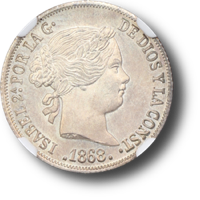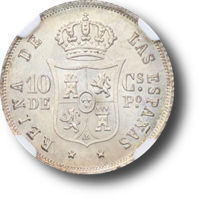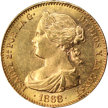50CP-1868m : 1868 50 centavos de peso Manila mint PCGS MS62
0.900 fine silver, 29.6mm, medal alignment, lettered edge: LEY PATRIA REY ⚜ ⚜ ⚜
Type: Laureate Head Right
The coins of the Spanish Philippines (until 1837) include:
Silver: countermarked Spanish colonial coinage
The coins of the Spanish Philippines (1835) include:
Copper: 1, 2, 4 quartos
The coins of the Spanish Philippines (1861-1868) include:
Silver: 10, 20, 50 centavos de peso
Gold: 1, 2, 4 pesos
Spanish Philippines (1833 - 1868)

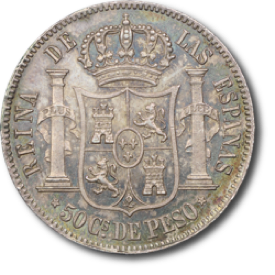
4P-1868m : 1868 4 pesos Manila mint PCGS MS64
0.875 fine gold, 21mm, medal alignment, reeded edge
Type: Laureate Head Left
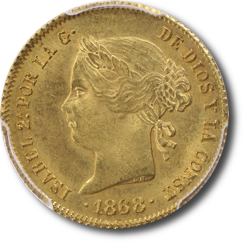
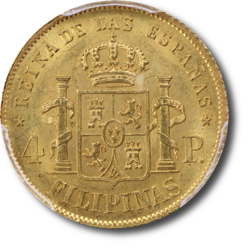
The Spanish Philippines was a busy trading port due to its proximity to China, Japan, Australia, and the Americas. In the early 1800's Spain was struggling with France and many of its South American colonies were declaring independence. This appears to have left little time for proper management of its other colonies. As such, the Spanish Philippines subsisted on countermarked coinage until the mid 1830's when copper coins were locally made. It was not until the late 1850's that Spain decided to establish a mint in the Philippines. In 1861 the mint was completed and began striking official coinage.
The need for coinage in the Philippines for both everyday commerce and the international trade passing through resulted in heavy use of coins that entered circulation there. More so than any other coins of her reign, the coins of the Spanish Philippines which depict Isabel II are extremely difficult to find in grades above XF. Even eye appealing VF and XF examples are hard to come by and are treasured by collectors.
The Isabel II silver 50 centavos de peso was minted from 1865 to 1868 and has only one type. It is identical in size and weight to the 1 escudo of Spain and has the same design elements with the exception of the denomination on the reverse and the five pointed stars surrounding it. The five pointed stars identify it as a product of the Manila mint.
The coin pictured above is an uncirculated example. It has lovely champagne toning with some mottled darker toning below and left of the bust on the obverse. The reverse has similar champagne toning on the devices with amazing rainbow iridescence throughout the fields. The finest example of this issue seen by this author.
The Isabel II gold 4 peso was minted from 1861 to 1868 and has only one type. It is slightly smaller in diameter and weight than the Spanish 100 reales and 10 escudos coins. This is the only gold coin to use the Young Laureate Head type and the only appearance of the Young Laureate Head facing left on any coin of her reign. Among the coins of Isabel II this reverse design is unique. The "4" and "P" on either side of the central device and the "FILIPINAS" legend below identify this as a coin of the Philippines. The five pointed stars between the denomination and upper legend identify the Manila mint.
The coin pictured above has some minor marks over the fields, cheek, and neck with strong luster over most of the surfaces on the obverse. The lustrous highlights of the laureate, hair, and much of Isabel's face beautifully accentuate the design of the obverse. The reverse of this coin has few marks on the pillars and other devices with full mint luster throughout. The white area on reverse is on the holder, not the coin. The finest example of this issue seen by this author.
10CP-1868m : 1868 10 centavos de peso Manila mint NGC MS65
0.900 fine silver, 18mm, medal alignment, reeded edge
Type: Laureate Head Right
The Isabel II silver 10 centavos de peso was minted from 1865 to 1868 and has only one type. It is similar in size and weight to the 2 reales of Spain and has the same design elements with the exception of the denomination on the reverse and the five pointed stars surrounding it. The five pointed stars identify it as a product of the Manila mint.
The coin pictured above is an uncirculated example. It has lovely champagne toning and bold luster on both obverse and reverse. The finest example of this issue seen by this author.
